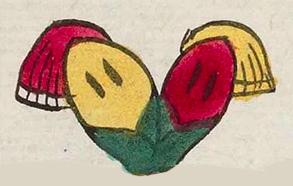cintli (Mdz49r)
This element for dried maize cobs (cintli)] has been carved from the compound sign for the place name, Teocinyocan. The two ears of corn are shown here in different colors (red with yellow silk and yellow with red silk, and green leaves wrapped tightly at the base. Each ear has two hash marks that have the appearance of a face. These marks are quite like the parallel, vertical, black marks that can be found on tortillas (see below). So, perhaps these vertical black lines have a meaning of maize. They are thinner than the lines for the syllabogram "hua."
Stephanie Wood
Another pair of cobs in red and yellow (or golden) with opposing colors for silk and hash marks that are reminiscent of faces can be found in the Codex Telleriano-Remensis. See below.
When dried maize kernels are taken from the cobs, they are then ground and used for making all kinds of foods. See below for an example of tlaolli, the dried maize kernels as they were drawn separated from the cob.
Stephanie Wood
c. 1541, but by 1553 at the latest
maíz, maize, corn, cobs, mazorcas, centli
cintli. This stone receptacle, or tepetlacalli, is decorated with a total of sixteen ears of maize. Museo Nacional de Antropología e Historia, Salón Mexica. Photograph by Stephanie Wood, 14 February 2023.

cin(tli), dried ears of maize, https://nahuatl.wired-humanities.org/content/cintli
Codex Mendoza, folio 49 recto, https://digital.bodleian.ox.ac.uk/objects/2fea788e-2aa2-4f08-b6d9-648c00..., image 108 of 188.
The Bodleian Libraries, University of Oxford, hold the original manuscript, the MS. Arch. Selden. A. 1. This image is published here under the UK Creative Commons, “Attribution-NonCommercial-ShareAlike 3.0 License” (CC-BY-NC-SA 3.0).



